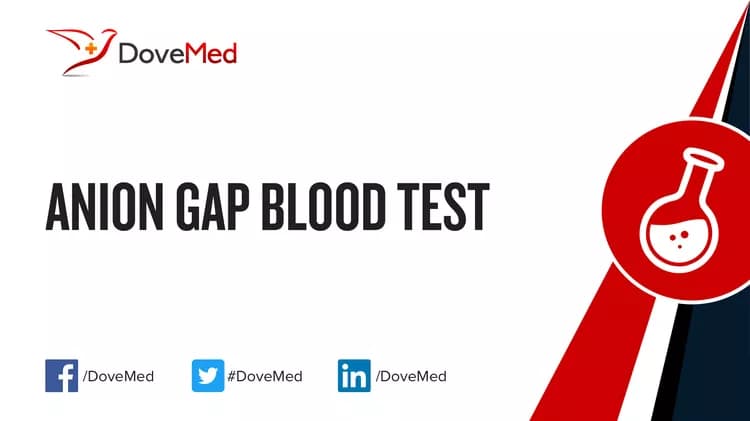What are other Names for this Test? (Equivalent Terms)
- AG Blood Test
What is Anion Gap Blood Test? (Background Information)
- The anion gap (AG) is the difference in concentrations between negatively-charged electrolytes (anions) and positively-charged electrolytes (cations). The difference is referred to as the anion gap, because there are more anions than cations in blood
- Electrolytes are chemicals that conduct an electrical current because of their electric charge, either positive or negative. Electrolytes are important to the body’s acid-base, electrical, and water pressure stability
- Electrolytes are mainly acquired through the diet. Major electrolytes include sodium (Na+), potassium (K+), chloride (Cl-), bicarbonate (HCO3-), and phosphate (HPO42-)
- Sodium is the most abundant cation in the fluid surrounding the cells. Potassium is the most abundant cation inside the cells. Chloride is the most abundant anion in the fluid surrounding the cells. Phosphate is the most abundant anion inside the cells
- One of the characteristics of electrolytes that make them important to the body is their acid-base balancing ability. Certain electrolytes, such as bicarbonate and phosphate, act as buffers
- Buffers help body fluids (such as blood) maintain a narrow pH range in the face of fluctuating levels of acidifying and alkalizing byproducts. Were it not for buffers, blood and other fluids would be susceptible to rapid and damaging pH changes
- Another reason electrolytes are important is their electrical conductivity. Electrically-active cells, such as muscle cells and neurons, rely on electrolytes to transmit electrical impulses vital to their function
- A third reason electrolytes are needed is that they allow cells to regulate the flow of water across their membranes. This is called osmotic regulation. Osmotic regulation protects cells from bursting due to an influx of water if their surroundings lack salt
- The Anion Gap Blood Test determines the difference in blood concentrations between anions and cations. It is used to investigate a possible electrolyte imbalance and metabolic disorder
What are the Clinical Indications for performing the Anion Gap Blood Test?
Following are the clinical indications for performing the Anion Gap Blood Test:
- Monitoring the effects of diuretic drugs
- Abnormal blood pressure
- Muscle twitches and spasms
- Muscle fatigue
- Nausea
- Vomiting
- Diarrhea
- Abnormal heart rhythms
- Large changes in the amount of urine produced
- Significant trauma and/or blood loss
- Altered mental status
How is the Specimen Collected for Anion Gap Blood Test?
Following is the specimen collection process for Anion Gap Blood Test:
Sample required: Blood
Process of obtaining blood sample in adults:
- A band is wrapped around the arm, 3-4 inches above the collection site (superficial vein that lies within the elbow pit)
- The site is cleaned with 70% alcohol in an outward spiral, away from the zone of needle insertion
- The needle cap is removed and is held in line with the vein, pulling the skin tight
- With a small and quick thrust, the vein is penetrated using the needle
- The required amount of blood sample is collected by pulling the plunger of the syringe out slowly
- The wrap band is removed, gauze is placed on the collection site, and the needle is removed
- The blood is immediately transferred into the blood container, which has the appropriate preservative/clot activator/anti-coagulant
- The syringe and the needle are disposed into the appropriate “sharp container” for safe and hygienic disposal
Preparation required: No special preparation is needed prior to the test.
What is the Significance of the Anion Gap Blood Test Result?
The significance of the Anion Gap Blood Test result is explained:
- A high test value may indicate:
- Lactic acidosis
- Hyperalbuminemia
- Hyperosmolar hyperglycemic nonketotic coma
- Uremia
- Ethylene glycol or methanol poisoning
- A low test value may indicate:
- Hypoalbuminemia
- Hypocalcemia
- Hypomagnesemia
- Hyperchloremia
- Multiple myeloma
- Paraproteinemias
- Polyclonal gammopathies
The laboratory test results are NOT to be interpreted as results of a "stand-alone" test. The test results have to be interpreted after correlating with suitable clinical findings and additional supplemental tests/information. Your healthcare providers will explain the meaning of your tests results, based on the overall clinical scenario.
Additional and Relevant Useful Information:
- Certain factors interfere with the results of the Anion Gap Blood Test. These include pregnancy and consumption of electrolyte-rich foods
- Increases in both anions and cations may cancel each other out, leaving the test value unchanged
Certain medications that you may be currently taking may influence the outcome of the test. Hence, it is important to inform your healthcare provider of the complete list of medications (including any herbal supplements) you are currently taking. This will help the healthcare provider interpret your test results more accurately and avoid unnecessary chances of a misdiagnosis.
The following DoveMed website links are some useful resources for additional information:
https://www.dovemed.com/common-procedures/procedures-laboratory/electrolyte-panel-blood-test/
https://www.dovemed.com/common-procedures/procedures-laboratory/ace-test/
https://www.dovemed.com/healthy-living/wellness-center/tips-to-increase-water-intake/
Please visit our Laboratory Procedures Center for more physician-approved health information:
http://www.dovemed.com/common-procedures/procedures-laboratory/
Related Articles
Test Your Knowledge
Asked by users
Related Centers
Related Specialties
Related Physicians
Related Procedures
Related Resources
Join DoveHubs
and connect with fellow professionals


0 Comments
Please log in to post a comment.